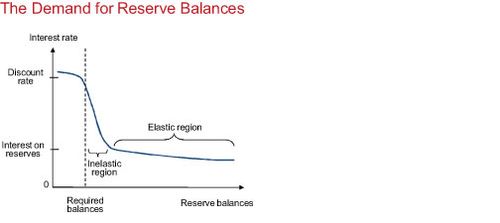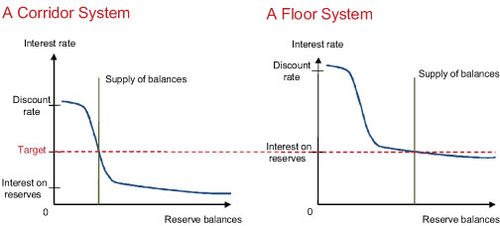Todd Keister
As part of its prudent planning for future developments, the Federal Open Market Committee (FOMC) has discussed strategies for normalizing the conduct of monetary policy, when appropriate, as the economy strengthens. One issue, raised in April 2011, is whether the longer-run framework for implementing monetary policy will be a corridor-type system or a floor-type system. What do these terms mean, and how do they relate to monetary policy? In this post, I describe the key differences between these two approaches to implementing monetary policy and some of the advantages offered by each.
The Federal Reserve conducts monetary policy by choosing a target for the federal funds rate, which is the average, market-determined interest rate at which banks and certain other institutions lend funds to each other on an overnight basis. The Federal Reserve has several tools that it can use to influence conditions in the federal funds market and thereby steer the market interest rate toward the chosen target. The terms “corridor” and “floor” refer to different procedures for combining the various tools to achieve this objective.
Two important tools are the discount rate and the interest-on-reserves rate. The discount rate is the interest rate at which the Federal Reserve is willing to lend funds, against collateral, to banks in good standing. This rate tends to create an upper bound, or ceiling, for the market interest rate by giving banks an option to borrow funds outside of the market. The discount rate is currently 0.75 percent. The interest-on-reserves rate represents what banks earn on the funds deposited in their accounts at the Federal Reserve. This rate tends to create a lower bound, or floor, for the market interest rate on interbank loans by removing any incentive for banks to lend funds at a lower rate. The interest-on-reserves rate is currently 0.25 percent.
The Demand for Reserve Balances
The “funds” being lent in the fed funds market are balances that banks and other institutions hold on deposit at the Federal Reserve. (These balances are sometimes called federal funds.) Banks hold these balances for a variety of reasons: to meet reserve requirements, to make payments to other banks, and as part of their general pool of liquid assets. Banks’ demand for these balances can be represented graphically as depicted in the figure below. The vertical axis in the figure measures the market interest rate on overnight fed funds loans, and the horizontal axis measures the total quantity of reserve balances.
To understand the shape of the demand curve in this figure, suppose first that the supply of reserve balances is very small. In this case, some banks will have difficulty meeting their reserve requirement. As these banks try to borrow funds, the market interest rate will be pushed up toward the ceiling created by the discount rate. (The market rate may actually rise above the discount rate, as depicted in the figure; I return to this issue at the end of the post.)
Once the supply of balances becomes large enough that all banks expect to meet their requirements, the demand curve falls off sharply. At this point, the value of reserve balances is determined largely by banks’ desire to be able to make payments out of their account as needed without the risk of falling below their requirement. This part of the curve is labeled the inelastic region in the figure; the term “inelastic” here means that the quantity of balances banks demand is relatively insensitive to changes in the interest rate.
As the supply of balances increases further, the demand curve flattens out into an elastic region where the demand for balances is much more sensitive to changes in the interest rate. In this region, banks have sufficient balances to meet their reserve requirements comfortably while satisfying all payments needs. The value of reserve balances in this region comes largely from the fact that these balances are a perfectly liquid, interest-bearing asset that banks can hold as part of their general liquidity pools. The interest-on-reserves rate that banks earn by holding these balances is, therefore, the relevant reference point for the market interest rate.
The Supply of Reserve Balances
The Federal Reserve’s third key tool for influencing market interest rates is changing the total supply of reserve balances through open market operations—that is, buying securities in the market to increase balances or selling securities to decrease balances. A change in the supply of balances moves the market to a different point on the demand curve in the figure above, which then brings about a corresponding change in the market interest rate.
Corridors and Floors
Once the FOMC determines a target interest rate, the Federal Reserve has different ways of using the tools described above to implement this decision. A corridor-style system is depicted in the left panel of the figure below: The discount rate is set above the target interest rate and the interest-on-reserves rate is set below it. These two rates form a “corridor” that will contain the market interest rate; the target rate is often (but not always) set in the middle of this corridor. Open market operations are then used as needed to change the supply of reserve balances so that the market interest rate is as close as possible to the target. Notice in particular that this approach relies on setting the supply of balances so that it falls in the inelastic region of the demand curve.
The right panel of the figure depicts a floor-type system. In this approach, the interest-on-reserves rate is set very close or equal to the target rate. The open market desk again supplies reserve balances as needed to steer the market interest rate to the target. In this case, the appropriate supply of balances falls in the elastic region of the demand curve and the market rate is close to the floor created by the interest-on-reserves rate.
It is worth emphasizing that both approaches are consistent with the view, expressed by the FOMC in June 2011, that the quantity of reserve balances should be kept to the “smallest levels that would be consistent with the efficient implementatio
n of monetary policy.” While the level of balances would be larger under a floor-type system, in each case this level is set precisely to meet banks’ demand for balances at the target interest rate.
Comparing Systems
Each of these approaches offers some advantages. Central banks have much more experience with corridor-type systems, in part because it is possible to operate one without paying interest on reserves. Notice that, in the left panel of the figure above, the approach would be largely unchanged if the interest-on-reserves rate were set to zero. A floor-type system, in contrast, requires that the interest-on-reserves rate be close to the FOMC’s target. Prior to October 2008, the Federal Reserve did not pay interest on reserve balances and operated a corridor-type system with the interest-on-reserves rate set to zero.
While a floor-type system is less familiar, it helps promote the efficient functioning of the financial system by allowing banks to earn the market rate of interest on all of their reserve balances. In a corridor-type system, the interest-on-reserves rate is lower than the market interest rate. Banks thus have an incentive to invest time and effort trying to economize on the quantity of balances they hold by lending extra funds to other banks or by purchasing other assets. However, all of the balances created by the Federal Reserve must be held by someone, so these efforts by individual banks to avoid holding balances simply cancel out. A floor-type system removes the incentive for banks to undertake such efforts. It also supplies banks with a larger quantity of this perfectly safe, liquid asset. A more detailed discussion of these efficiency concerns, and other differences between corridor-type and floor-type systems, can be found in two Federal Reserve publications, “Divorcing Money from Monetary Policy” and “Understanding Monetary Policy Implementation.”
Leaky Ceilings and Soggy Floors
One final note: The terms “ceiling” and “floor” are somewhat misleading in that the discount rate and the interest-on-reserves rate do not create firm bounds for the market interest rate. For example, banks may choose to borrow in the market at a rate higher than the discount rate because they fear that borrowing from the Federal Reserve could be interpreted as a sign of weakness (see some theory, discussion, and evidence of this “stigma” effect). On the other side of the corridor, some lenders in the federal funds market are not eligible to earn interest on reserves and hence may be willing to lend in the market at lower rates. The government-sponsored enterprises Fannie Mae, Freddie Mac, and the Federal Home Loan Banks fall into this category. The effective federal funds rate has, in fact, been lower than the interest-on-reserves rate for much of the recent period. A discussion of these and related issues can be found in the Federal Reserve publication “Monetary Policy under a Corridor Operating Framework.”
Disclaimer
The views expressed in this post are those of the author and do not necessarily reflect the position of the Federal Reserve Bank of New York or the Federal Reserve System. Any errors or omissions are the responsibility of the author.












 RSS Feed
RSS Feed Follow Liberty Street Economics
Follow Liberty Street Economics
The “floor” is just a “black hole”, sucking the life out of the economy. IOeRs invert the short-end of the yield curve. IOeRs not only absorb bank deposits (acting as a credit control device), they absorb monetary savings from the both the commercial banks & the non-banks. IOeRs decrease the supply of loan-funds (monetary savings), in the long-term market. IOeRs induce dis-intermediation (where the financial intermediaries shrink in size but the commercial banking system stays the same). The most important lending sector in our economy (the non-banks) — or pre-Great Recession, represented 82% of the pooling & lending markets (Z.1 release, sectors, e.g., MMMFs, commercial paper, GSEs, etc.). IOeRs result in a cessation of circuit income, & the transactions velocity of funds. They propagate stagflation. They reduce real-output.
A good read for a economics undergrad!
A very academic but useful post for a economics undergrad!